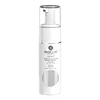What's inside
What's inside
 Key Ingredients
Key Ingredients

 Benefits
Benefits

 Concerns
Concerns

No concerns
 Ingredients Side-by-side
Ingredients Side-by-side

Water
Skin ConditioningGlycerin
HumectantSodium Cocoamphoacetate
CleansingSerine
MaskingPentylene Glycol
Skin ConditioningPanthenol
Skin ConditioningEctoin
Skin ConditioningXylitylglucoside
HumectantAlpha-Glucan Oligosaccharide
CleansingAsiaticoside
AntioxidantMadecassoside
AntioxidantBeta-Glucan
Skin ConditioningAllantoin
Skin ConditioningGluconolactone
Skin ConditioningInulin
Skin ConditioningCentella Asiatica Leaf Extract
Skin ConditioningAnhydroxylitol
HumectantSodium Cocoyl Amino Acids
CleansingPersea Gratissima Oil
Skin ConditioningXylitol
HumectantFructose
HumectantCalcium Gluconate
HumectantGlucose
HumectantLactic Acid
BufferingXanthan Gum
EmulsifyingCellulose Gum
Emulsion StabilisingCellulose
AbsorbentHydrolyzed Caesalpinia Spinosa Gum
AbsorbentCaesalpinia Spinosa Gum
Skin ConditioningHydroxyacetophenone
AntioxidantSodium Benzoate
MaskingPotassium Sorbate
PreservativeWater, Glycerin, Sodium Cocoamphoacetate, Serine, Pentylene Glycol, Panthenol, Ectoin, Xylitylglucoside, Alpha-Glucan Oligosaccharide, Asiaticoside, Madecassoside, Beta-Glucan, Allantoin, Gluconolactone, Inulin, Centella Asiatica Leaf Extract, Anhydroxylitol, Sodium Cocoyl Amino Acids, Persea Gratissima Oil, Xylitol, Fructose, Calcium Gluconate, Glucose, Lactic Acid, Xanthan Gum, Cellulose Gum, Cellulose, Hydrolyzed Caesalpinia Spinosa Gum, Caesalpinia Spinosa Gum, Hydroxyacetophenone, Sodium Benzoate, Potassium Sorbate
Centella Asiatica Leaf Water 69%
Skin ConditioningWater
Skin ConditioningDisodium Cocoamphodiacetate
Cleansing1,2-Hexanediol
Skin ConditioningSodium Chloride
MaskingTea-Cocoyl Glutamate
CleansingHexylene Glycol
EmulsifyingCitric Acid
BufferingPolyglyceryl-4 Caprate
EmulsifyingPentylene Glycol
Skin ConditioningButylene Glycol
HumectantCaprylyl Glycol
EmollientTrehalose
HumectantAllantoin
Skin ConditioningGlycerin
HumectantMelaleuca Alternifolia Leaf Water
AntimicrobialOryza Sativa Bran Extract
Skin ConditioningPortulaca Oleracea Extract
Skin ConditioningPerilla Frutescens Leaf Extract
MaskingAspalathus Linearis Extract
Skin ConditioningCommiphora Myrrha Resin Extract
Skin ConditioningGlycyrrhiza Glabra Root Extract
BleachingEthylhexylglycerin
Skin ConditioningCentella Asiatica Leaf Water 69%, Water, Disodium Cocoamphodiacetate, 1,2-Hexanediol, Sodium Chloride, Tea-Cocoyl Glutamate, Hexylene Glycol, Citric Acid, Polyglyceryl-4 Caprate, Pentylene Glycol, Butylene Glycol, Caprylyl Glycol, Trehalose, Allantoin, Glycerin, Melaleuca Alternifolia Leaf Water, Oryza Sativa Bran Extract, Portulaca Oleracea Extract, Perilla Frutescens Leaf Extract, Aspalathus Linearis Extract, Commiphora Myrrha Resin Extract, Glycyrrhiza Glabra Root Extract, Ethylhexylglycerin
Ingredients Explained
These ingredients are found in both products.
Ingredients higher up in an ingredient list are typically present in a larger amount.
Allantoin is a soothing ingredient known for its protective and moisturizingg properties. Because of this, it is often added to products with strong active ingredients.
Studies show higher concentrations of this ingredient can promote wound healing.
Though it can be derived from the comfrey plant, allantoin is produced synthetically for cosmetic products to ensure purity.
Learn more about AllantoinGlycerin is already naturally found in your skin. It helps moisturize and protect your skin.
A study from 2016 found glycerin to be more effective as a humectant than AHAs and hyaluronic acid.
As a humectant, it helps the skin stay hydrated by pulling moisture to your skin. The low molecular weight of glycerin allows it to pull moisture into the deeper layers of your skin.
Hydrated skin improves your skin barrier; Your skin barrier helps protect against irritants and bacteria.
Glycerin has also been found to have antimicrobial and antiviral properties. Due to these properties, glycerin is often used in wound and burn treatments.
In cosmetics, glycerin is usually derived from plants such as soybean or palm. However, it can also be sourced from animals, such as tallow or animal fat.
This ingredient is organic, colorless, odorless, and non-toxic.
Glycerin is the name for this ingredient in American English. British English uses Glycerol/Glycerine.
Learn more about GlycerinPentylene glycol is typically used within a product to thicken it. It also adds a smooth, soft, and moisturizing feel to the product. It is naturally found in plants such as sugar beets.
The hydrophilic trait of Pentylene Glycol makes it a humectant. As a humectant, Pentylene Glycol helps draw moisture from the air to your skin. This can help keep your skin hydrated.
This property also makes Pentylene Glycol a great texture enhancer. It can also help thicken or stabilize a product.
Pentylene Glycol also acts as a mild preservative and helps to keep a product microbe-free.
Some people may experience mild eye and skin irritation from Pentylene Glycol. We always recommend speaking with a professional about using this ingredient in your routine.
Pentylene Glycol has a low molecular weight and is part of the 1,2-glycol family.
Learn more about Pentylene GlycolWater. It's the most common cosmetic ingredient of all. You'll usually see it at the top of ingredient lists, meaning that it makes up the largest part of the product.
So why is it so popular? Water most often acts as a solvent - this means that it helps dissolve other ingredients into the formulation.
You'll also recognize water as that liquid we all need to stay alive. If you see this, drink a glass of water. Stay hydrated!
Learn more about Water